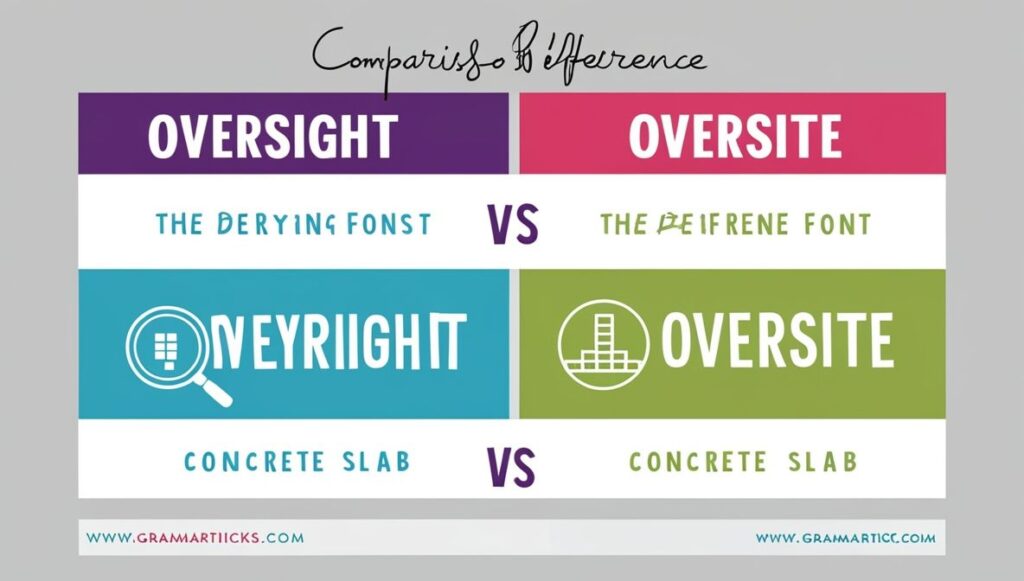In everyday writing and conversation, it’s easy to confuse words that sound alike but have completely different meanings. One common pair that trips people up is Oversight vs Oversite. Though they share pronunciation, their definitions, usage, and contexts couldn’t be more different. Understanding Oversight vs Oversite helps you avoid mistakes that can lead to confusion in both professional and technical settings.
Whether you’re writing a report, managing a team, or working on a building site, knowing the correct use of Oversight vs Oversite is essential. This guide breaks down each term clearly and gives you real-world tips to remember the difference. Once you get it, Oversight vs Oversite will never slow you down again.
Understanding Oversight
Oversight, as a noun, can mean either supervision and management or an inadvertent omission. In corporate settings or professional writing, regulatory oversight and managerial oversight refer to authority and control. But an oversight can also just be a little error or lapse a lack of attention.
It’s one of those commonly confused words with multiple senses. In formal context, using oversight definition correctly helps ensure communication clarity.
Examples:
Scenario A – Supervision
- “The safety oversight committee will review new equipment.” Here, oversight means management and control.
Scenario B – Error
- “I left the figures out by accident that was an oversight.” This one shows oversight as a mistake.
Exploring Oversite
Oversite meaning refers to a specific term in construction, especially in British English usage. It describes the foundation layer or ground-level slab poured with hardcore materials and concrete layer to prevent moisture under floors.
This construction terminology is niche, but crucial during site preparation or building work. It’s not just an architecture buzzword it’s a literal structural component.
Examples:
- “Install a damp-proof course above the oversite concrete for stability.”
- “The contractor poured the oversite before adding flooring.”
Oversight vs Oversite – Core Differences

Here’s a quick comparison table that highlights the difference between oversight and oversite:
| Feature | Oversight | Oversite |
| Meaning | Supervision or mistake | Foundation or ground layer |
| Context / Industry | Corporate, legal, regulatory, educational | Construction, architecture, engineering |
| Modern Usage | Very common | Rare, specialized |
| Synonyms | Supervision, error, negligence, lapse | Concrete layer, sub‑flooring, foundation |
When writing, pick the right term to avoid miscommunication in business communication or construction jargon.
Scenario Examples to Clarify

Examples drive familiarity. Here are scenarios where using the wrong term would confuse readers or colleagues:
Misused in Business Email
- Wrong: “We need oversite on project approvals.”
- Right: “We need oversight on project approvals.”
Construction Context
- Wrong: “Make sure there’s sufficient oversight under the slab.”
- Right: “Make sure there’s sufficient oversite under the slab.”
A correct match assures communication clarity whether you’re drafting corporate memos or construction contracts.
Tips to Avoid Confusion
Confidence comes from habit. Use these mnemonic devices and strategies:
- Think oversite = site → construction ground layer.
- Think oversight = from oversee → supervision or managing.
- Visual cue: sight → what you see (monitoring vs ground).
- Practice writing both in phrases or fill-in-the‑blank exercises.
Try flashcards or labeling images: one of a manager and one of a slab. Reinforce the split in meaning with writing tips regularly.
Helpful Synonyms to Use
If you’re struggling to decide, consider using synonyms:
- For oversight (supervision): supervision, control, authority
- For oversight (error): omission, lapse, negligence
- For oversite: sub-flooring, foundation layer, concrete base
These substitutes often eliminate the confusion entirely.
FAQs
No. Its meaning strictly relates to construction or ground slabs and not to managing or monitoring.
Rarely. It’s mainly found in technical or British English usage for building terms.
Not at all. It can mean effective supervision or a harmless mistake, depending on context.
Mastering Oversight vs Oversite
Knowing when to use each word boosts both language precision and reputation. Remember:
- Use oversight when talking about supervision, control, or admitting an error.
- Reserve oversite exclusively for construction, architecture, or descriptions of building foundations.
Stick with visual cues, mnemonics, and synonyms to avoid language slips. With a little practice, you’ll handle them like a pro no confusion, ever.
Final Thoughts
Getting Oversight vs Oversite right is easier than it seems. Just remember, oversight means either a mistake or supervision. Oversite, on the other hand, is a construction term for a ground layer. They may sound the same, but they’re used in totally different ways.
Use Oversight vs Oversite correctly in your writing to avoid confusion. Think about the context business or building and choose the right word. With a little practice, you’ll spot the difference quickly. Mastering Oversight vs Oversite helps keep your communication clear, smart, and professional.

